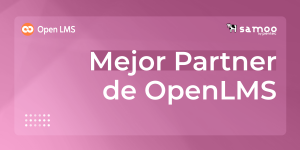

5 Differences of Open LMS vs. Moodle
- In today's post we are going to analyze the main differences between 2 of the e-learning platforms par excellence such as Open LMS and Moodle.
- Moodle is one of the best known learning management systems (LMS) globally, with presence in most countries. On the other hand, Open LMS is based on Moodle, a learning management system (LMS) that uses Moodle's open source technology to create unique learning experiences, offering a robust, scalable, functional and integrable learning environment.
- Since 2015, Samoo y OpenLMS present a strategic alliance, when it arrived in Spain from our hand as an alternative to Moodle, being a solution of guarantees for any type of entity.
- In many occasions the question of what are the differences between the 2 platforms arises, here we will focus on 5 differences between Open LMS and Moodle.
1-Flexibility and personalization of the user experience.
Ensuring an intuitive and innovative user experience is key in e-learning. Open LMS features Snap, a graphical theme that allows you to create fully customizable and scalable learning experiences, automate processes for each user and identify key behaviors in order to trigger additional help, enabling them to complete the course. You get a modern and attractive design, with intuitive and advanced navigation that offers a quality user experience.
Snap is available for Moodle, however, who provides the support service is Open LMS.
It is also worth mentioning the PLD (Personalized Learning Designer) tool within Open LMS. Open LMS, which allows diagnostic tests to be taken in order to customize the course content for the student, according to the results of his or her exam.
2-Exclusive functionalities in the mobile app.
The mobile application of Open LMSalso based on the Moodle open source code, offers exclusive functionalities such as:
- Drag & Drop question type evaluations
-Offline evaluations synchronized when connected to the Internet.
-Synchronization of the calendar with the users' personal calendar.
3-Open LMS works as a SaaS (Software as a service) service.
In Moodle, the institution or company must take care of the servers and infrastructure, on the contrary, Open LMS works with a Saas service (Software as a service) so the user does not have to worry about key aspects such as security and control.
4-Open LMS integrates more than 1000 plugins
Open LMS integrates a large number of plugins, extending its functionalities and providing extra value to online education.
All of them have been reviewed and approved by experts in the field.
Some, such as Conduit, are exclusive to Open LMS, allowing you to automate administrative tasks and save time.
5-Open source solutions
Open LMS configures and manages open source LMS solutions. Providing maximum flexibility to build the ideal solution. Open source technologies integrate with a variety of plugins, support many types of content and can be customized to meet your objectives.
Conclusions
We hope you liked the post where we checked how to use Open LMS is an e-learning provider that has the flexibility, the necessary tools and integrations and the content to create unique learning experiences, taking the best of open source innovation and the guarantees and advantages of a SaaS service. Partnering with educational institutions and organizations from all sectors and industries to create learning experiences without limits.




